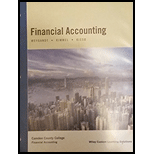
Concept explainers
Periodic Inventory System: It is a system in which the inventory is updated in the accounting records on a periodic basis such as at the end of each month, quarter or year. In other words, it is an accounting method which is used to determine the amount of inventory at the end of each accounting period.
In First-in-First-Out method, the cost of initially purchased items are considered as cost of goods sold, for the items which are sold first. The value of the ending inventory consists the recent purchased items.
In Last-in-First-Out method, the cost of last purchased items are considered as cost of goods sold, for the items which are sold first. The value of the closing stock consists the initial purchased items.
To Compute: The ending inventory at May 31, and cost of goods sold using the FIFO methods.
Want to see the full answer?
Check out a sample textbook solution
Chapter 6 Solutions
FINANCIAL ACCOUNTING W/WILEY+ >IP<
- Quick answer of this accounting questionarrow_forwardWhat is the purpose of adjusting entries in accounting? A) To close the temporary accounts B) To update the financial records at the end of an accounting period C) To prepare the trial balance D) To record transactions that occurred in the following periodarrow_forwardThe total factory overhead for Leicester Manufacturing is budgeted for the year at $756,000. Leicester manufactures two product lines: standard lamps and premium lamps. These products each require 4 direct labor hours to manufacture. Each product is budgeted for 8,000 units of production for the year. Determine the factory overhead allocated per unit for premium lamps using the single plantwide factory overhead rate.arrow_forward
- Which of the following is an example of an intangible asset? A) Buildings B) Patents C) Equipment D) Inventoryexplain.arrow_forwardIf a company has a profit margin of 10%, this means that:A) For every $1 of sales, the company earns $0.10 in profit.B) The company has $0.10 in expenses for every $1 of sales.C) The company’s revenue exceeds its expenses by 10%.D) The company’s assets exceed its liabilities by 10%.arrow_forwardPlease accounting problemarrow_forward
- Can you solve this general accounting problem using accurate calculation methods?arrow_forwardWhich of the following is NOT a current asset? A) Cash B) Accounts Receivable C) Prepaid Rent D) Landarrow_forwardPlease given correct answer for General accounting question I need step by step explanationarrow_forward

 AccountingAccountingISBN:9781337272094Author:WARREN, Carl S., Reeve, James M., Duchac, Jonathan E.Publisher:Cengage Learning,
AccountingAccountingISBN:9781337272094Author:WARREN, Carl S., Reeve, James M., Duchac, Jonathan E.Publisher:Cengage Learning, Accounting Information SystemsAccountingISBN:9781337619202Author:Hall, James A.Publisher:Cengage Learning,
Accounting Information SystemsAccountingISBN:9781337619202Author:Hall, James A.Publisher:Cengage Learning, Horngren's Cost Accounting: A Managerial Emphasis...AccountingISBN:9780134475585Author:Srikant M. Datar, Madhav V. RajanPublisher:PEARSON
Horngren's Cost Accounting: A Managerial Emphasis...AccountingISBN:9780134475585Author:Srikant M. Datar, Madhav V. RajanPublisher:PEARSON Intermediate AccountingAccountingISBN:9781259722660Author:J. David Spiceland, Mark W. Nelson, Wayne M ThomasPublisher:McGraw-Hill Education
Intermediate AccountingAccountingISBN:9781259722660Author:J. David Spiceland, Mark W. Nelson, Wayne M ThomasPublisher:McGraw-Hill Education Financial and Managerial AccountingAccountingISBN:9781259726705Author:John J Wild, Ken W. Shaw, Barbara Chiappetta Fundamental Accounting PrinciplesPublisher:McGraw-Hill Education
Financial and Managerial AccountingAccountingISBN:9781259726705Author:John J Wild, Ken W. Shaw, Barbara Chiappetta Fundamental Accounting PrinciplesPublisher:McGraw-Hill Education





